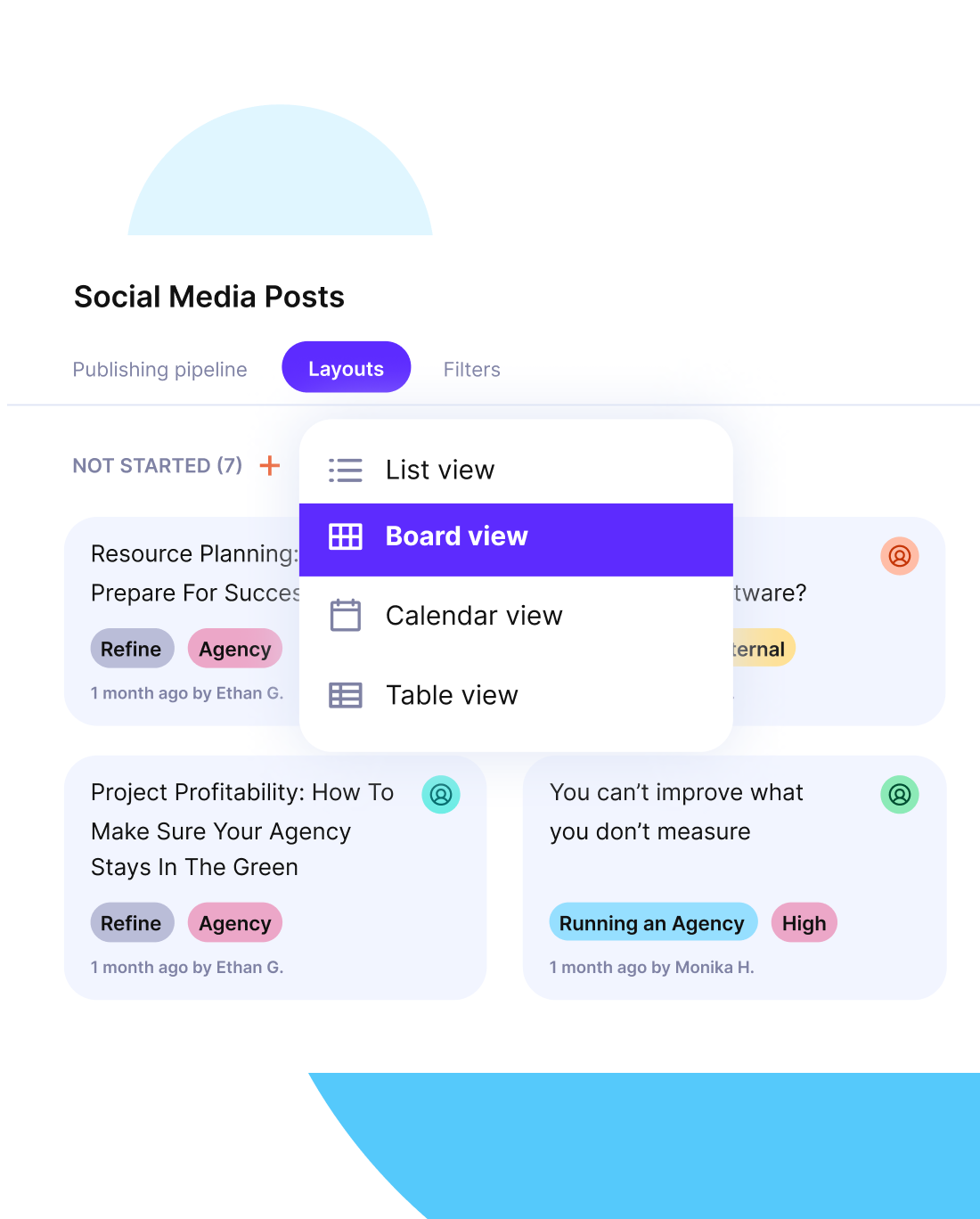Top 6 Project Estimation Techniques in 2026 + Best Practices
If you’re struggling with missed deadlines and bloated budgets, you’re not alone.
This guide to project estimation techniques will help you make realistic estimates for project scope, costs, timelines, required resources, and potential risks.
You’ll also learn how to overcome common challenges and which tools can support your process.
Key Takeaways
- Top-down estimation offers quick projections by starting from the overall scope.
- Bottom-up estimation builds precision by estimating individual tasks.
- Analogous and parametric techniques use historical data to model timelines and costs.
- Three-point estimation factors in risk by using optimistic, pessimistic, and likely outcomes.
What Are Project Estimation Techniques?
Project estimation techniques are the methods used to forecast time, cost, and resources needed to complete a project. They help you map out realistic expectations before work starts, giving your team and stakeholders a shared understanding of what’s achievable.
Why Project Estimations Matter?
Project estimation matters because it directly impacts your ability to plan realistically, manage risk, and maintain stakeholder trust. Without solid estimates, project management is doomed from the start; projects run late, go over budget, or fall apart due to unclear expectations.
Accurate project estimation methods give project managers early warning signs of potential roadblocks. They are so much more than nice-to-haves; these techniques shape your risk planning, build trust, and keep your team on track.
- Risk is easier to manage with strong estimations: when your estimations are accurate, it’s easier to identify where risks might appear and plan around them. You can spot delays in the project schedule before they happen and adjust your plan early.
- Stakeholders get more clarity (and fewer surprises): reliable estimations help stakeholders understand what’s possible and when. Regular updates based on progress improve transparency and reduce scope-related tension.
- Planning and accountability become more effective: estimations give your team clear targets and key data for efficient resource allocation. When people know what they’re responsible for and how long they have, accountability improves, and plans become more actionable.
What Should You Estimate in a Project?
In a project, you should always estimate the five constraints of scope, time, cost, resources, and risk.
Each of these elements directly impacts your ability to deliver on time and within budget, and together they form the foundation of any reliable project plan.
In order to create a realistic and effective plan, it’s essential to apply proven effort and cost estimation techniques that align with each of these five key constraints.
Below, we’ll explain what each area means, why it matters, and what technique to use to get accurate estimations of each constraint. Keep in mind that this is a brief review; we’ll talk more about the actual estimation techniques later in the article.
Estimate the Scope of Work
Scope defines what’s included in your project. The more precise your scope, the easier it is to break down the project into work packages and plan realistically.
- Why it matters: A vague or shifting scope leads to missed deadlines and overworked teams. It makes room for scope creep.
- How to do it: Use a Work Breakdown Structure (WBS) to split the project into smaller, clearly defined tasks. Review with stakeholders to confirm what’s in and what’s out. Make a scope statement to wrap everything up and start executing.
In case you need more help with this part, there’s an amazing Work Breakdown Structure guide on our blog.
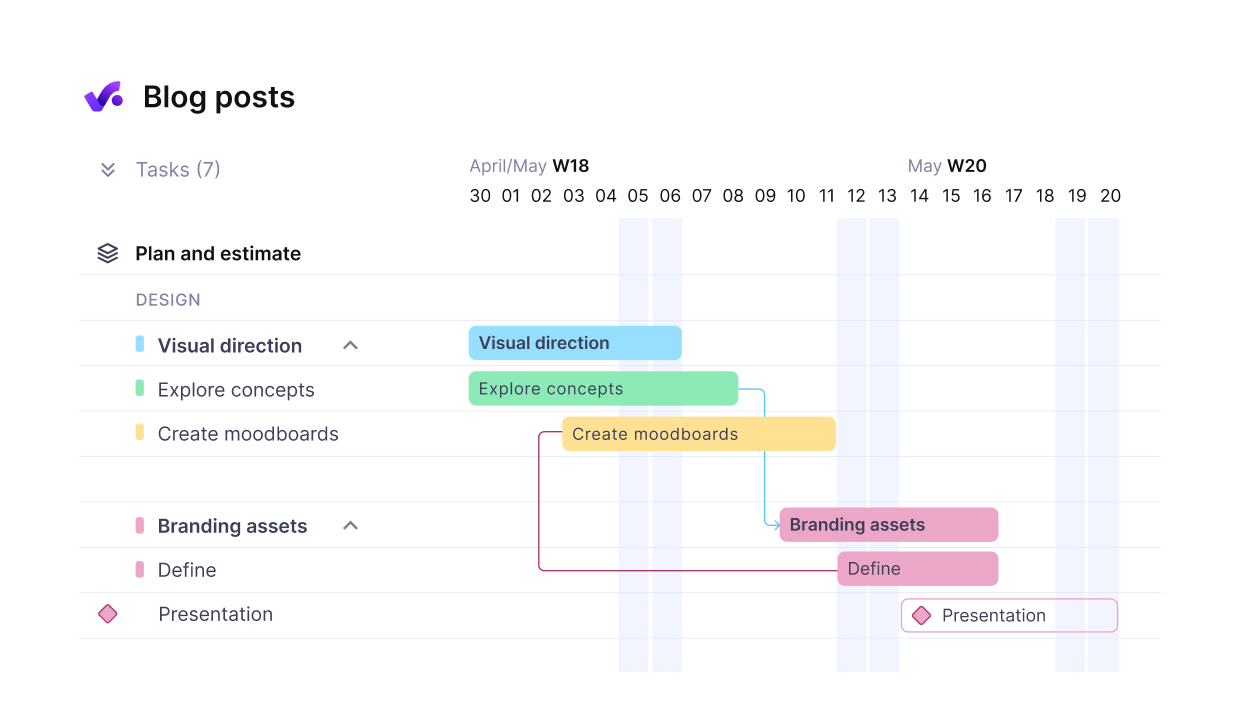
Break down projects in tasks with dependencies.
Estimate the Time Required
Time estimation means predicting how long each task or phase will take. Unrealistic timelines are a top reason projects fail. Teams need to know what’s expected and when.
- Why it matters: This is a big and often overlooked problem. Actually, according to the PMI’s Pulse of the Profession report, 26% of project failures are directly caused by inaccurate time estimations.
- How to do it: Assess task complexity and dependencies. Use historical data or expert input to build out a realistic schedule. Include buffer time where appropriate.
Estimate the Total Cost
Cost estimation includes every expense from salaries to software to overhead. Again, we’ll touch base on this later (hint: all-in-one project management tool that unifies billing, invoicing, and project budgets).
- Why it matters: Without a clear cost estimation in project management or any accurate forecasts, projects either stall from a lack of funding or go over budget.
- How to do it: When doing cost estimating, include both direct costs (labor, materials) and indirect costs (admin, contingency). Use past budgets or rate cards as a reference.
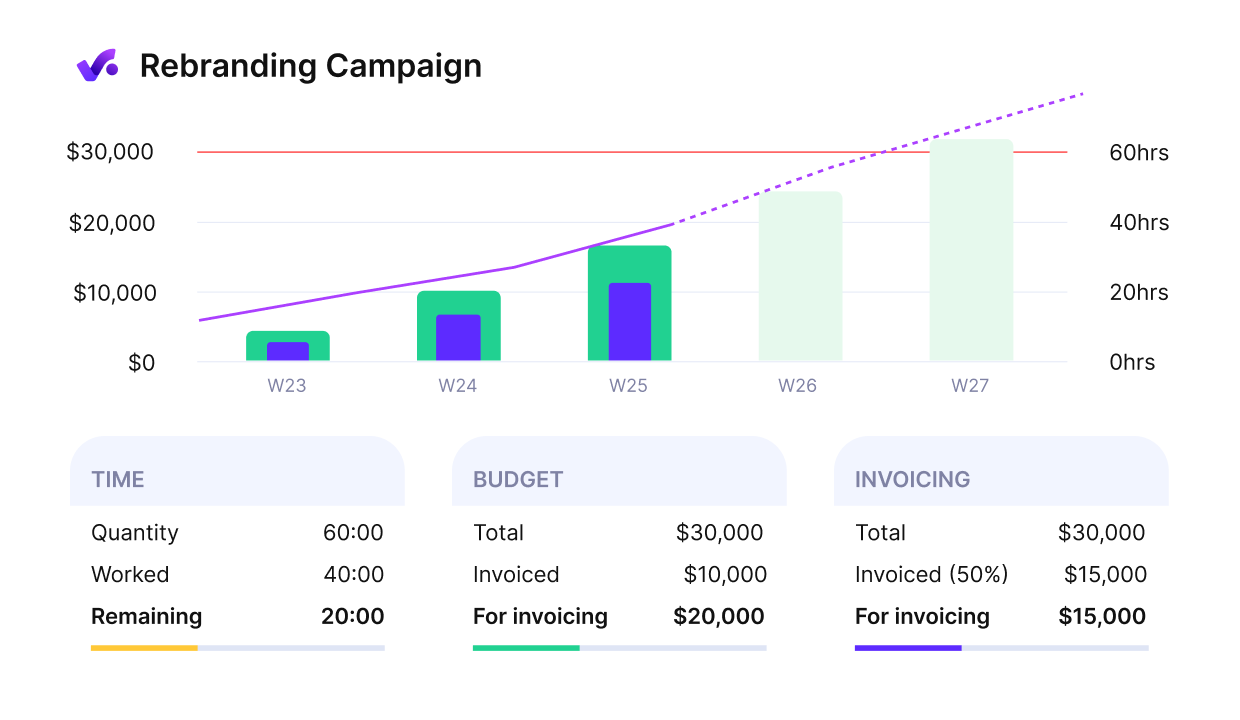
productive gives you an early warning of cost overruns.
Estimate the Resources You’ll Need
Resource estimation defines who (and what) is needed to get the work done. Ideally, you should use capacity planning software here. You can make a smarter decision and use a tool that ties resource management and capacity planning in a single platform.
- Why it matters: Misjudging resource management leads to bottlenecks, burnout, idle teams, or low resource utilization.
- How to do it: Map out team capacity, skill sets, and availability. Make sure the right people are available when tasks begin, and avoid double-booking.
You can also apply estimation techniques for WBS to align resource needs with each task, ensuring accurate assignment based on scope and workload breakdown.
Estimate Risk and Uncertainty
Risk estimation helps you spot what could go wrong before it does. Risk mitigation helps to reduce those risks.
- Why it matters: Ignoring risk causes projects to derail without warning.
- How to do it: Identify technical, staffing, and external risks. Use lessons from past projects and involve team members to surface weak spots. Document assumptions and track them over time.
If you’ve had problems with fragmented estimations or last-minute surprises, Productive helps unify scope, time, cost, and resourcing in one place, so nothing slips through the cracks.
Get realistic project estimates with Productive
What Are the Most Common Estimation Methods?
The most common estimation methods are top-down, bottom-up, analogous, parametric, three-point, and expert judgment. Each method has a different level of effort, accuracy, and use case.
Below, we break down all techniques, how they work and when to use them. If you’re a project manager that’s in charge for estimating, stick with this part.
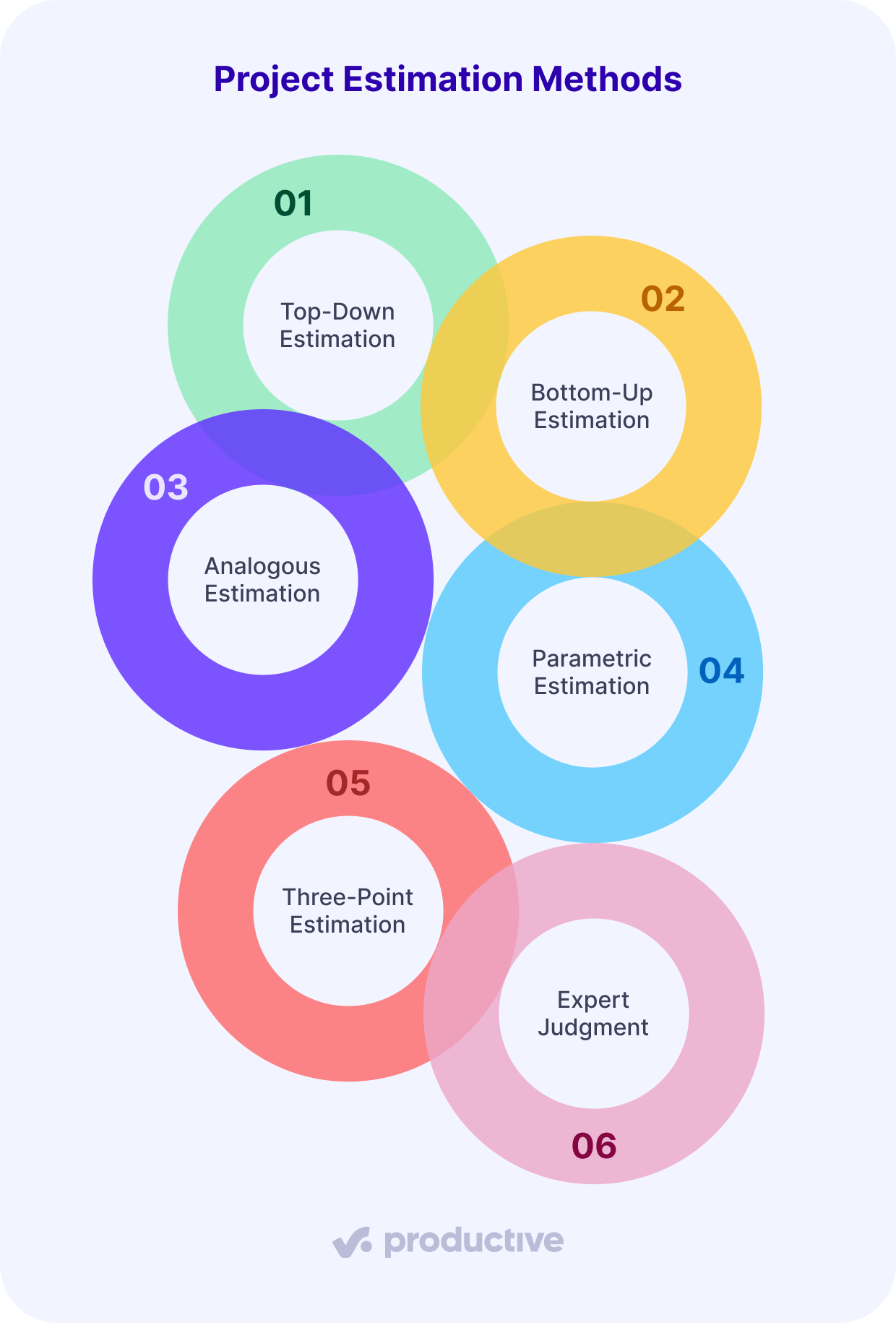
How to Use Top-Down Estimation?
Top-down estimation starts with the overall project scope and breaks it into smaller parts. It’s based on experience or high-level comparisons rather than task-level details.
- How it works: You estimate the total cost or duration and allocate portions of that across phases or deliverables.
- Practical Example: You estimate a branding project will take 100 hours total, then allocate 40 to design, 30 to content, and 30 to client revisions.
- Pros: Fast, useful for early scoping or client discussions.
- Cons: Prone to inaccuracies if task complexity isn’t well understood.
How to Use Bottom-Up Estimation?
Bottom-up estimation builds the total estimate by adding up all the individual task estimations. It requires a detailed breakdown of work.
- How it works: You estimate each task separately, then sum them up for the full timeline or budget.
- Practical Example: A web page has six tasks (writing, design, review, dev, testing, launch). Each is estimated separately, then totaled.
- Pros: Highly accurate if task details are known.
- Cons: Time-intensive; depends on solid task definitions.
How to Use Analogous Estimation?
Analogous estimating relies on past projects to predict future work. You compare your current project to similar ones.
- How it works: Look at historical data from a similar project and use it to estimate a new one.
- Practical Example: If a 10-page website took 150 hours before, a 15-page version might take 225.
- Pros: Fast; leverages real outcomes.
- Cons: Inaccurate if the new project differs significantly from the reference.
How to Use Parametric Estimation?
Parametric estimating uses formulas based on unit metrics, like cost per deliverable or hours per feature.
- How it works: You define a cost/time per unit and scale it up.
- Practical Example: If a single landing page takes 10 hours, and you need 8, your estimate is 80 hours.
- Pros: Efficient and data-driven.
- Cons: Only works if units are consistent and past data is reliable.
How to Use Three-Point Estimation?
Three-point estimation helps you account for risk by calculating best-case, worst-case, and most likely outcomes.
- How it works: Estimate three values: optimistic (O), pessimistic (P), and most likely (M). Then use the formula: (O + 4M + P) / 6.
- Practical Example: You estimate a task could take 2 (O), 5 (M), or 10 (P) days. The weighted average is (2 + 4×5 + 10) / 6 = 5.3 days.
- Pros: Helps manage uncertainty.
- Cons: Adds effort; requires experience to define realistic ranges.
How to Use Expert Judgment?
Expert judgment means getting estimates from people with experience, especially useful when data is lacking.
- How it works: Interview or consult senior team members or specialists.
- Practical Example: A developer estimates a new API integration will take 4 days based on similar past work.
- Pros: Quick and context-aware.
- Cons: Subjective; accuracy varies by expert.
What Affects the Accuracy of Your Estimates?
The accuracy of your project estimates depends on the project complexity, team experience, quality of historical data, resource availability, and external market conditions.
Each of these influences how closely your estimates align with reality. To make it easier for you to understand these factors, we’ve made a short table overview.
| Factor | Why It Affects Accuracy | What To Do About It |
|---|---|---|
| Project Complexity | More dependencies, uncertainty, and moving parts make it harder to estimate accurately. | Use a detailed Work Breakdown Structure (WBS) to break work into clear, manageable tasks. |
| Team Experience | Inexperienced teams often miss hidden steps or misjudge task duration. | Involve subject matter experts and review assumptions together. |
| Historical Data | Without past project data, estimations are based on guesswork rather than evidence. | Collect and reuse data from past projects to inform future time and cost estimations. |
| Resource Availability | Assuming full availability when people are split across projects leads to unrealistic timelines. | Use resource planning tools to check actual capacity and adjust your schedule based on real availability. |
How to Improve Project Estimation (Best Practices)?
You can improve project estimations by defining detailed requirements, involving subject matter experts, using collaborative tools, applying iterative estimation techniques, monitoring estimates against actuals, and learning from past work.
These practices help reduce uncertainty, avoid over- or underestimating tasks, and keep your estimations useful throughout the project lifecycle. Below, we break down how to apply each of these practices so your estimates hold up in the real world.
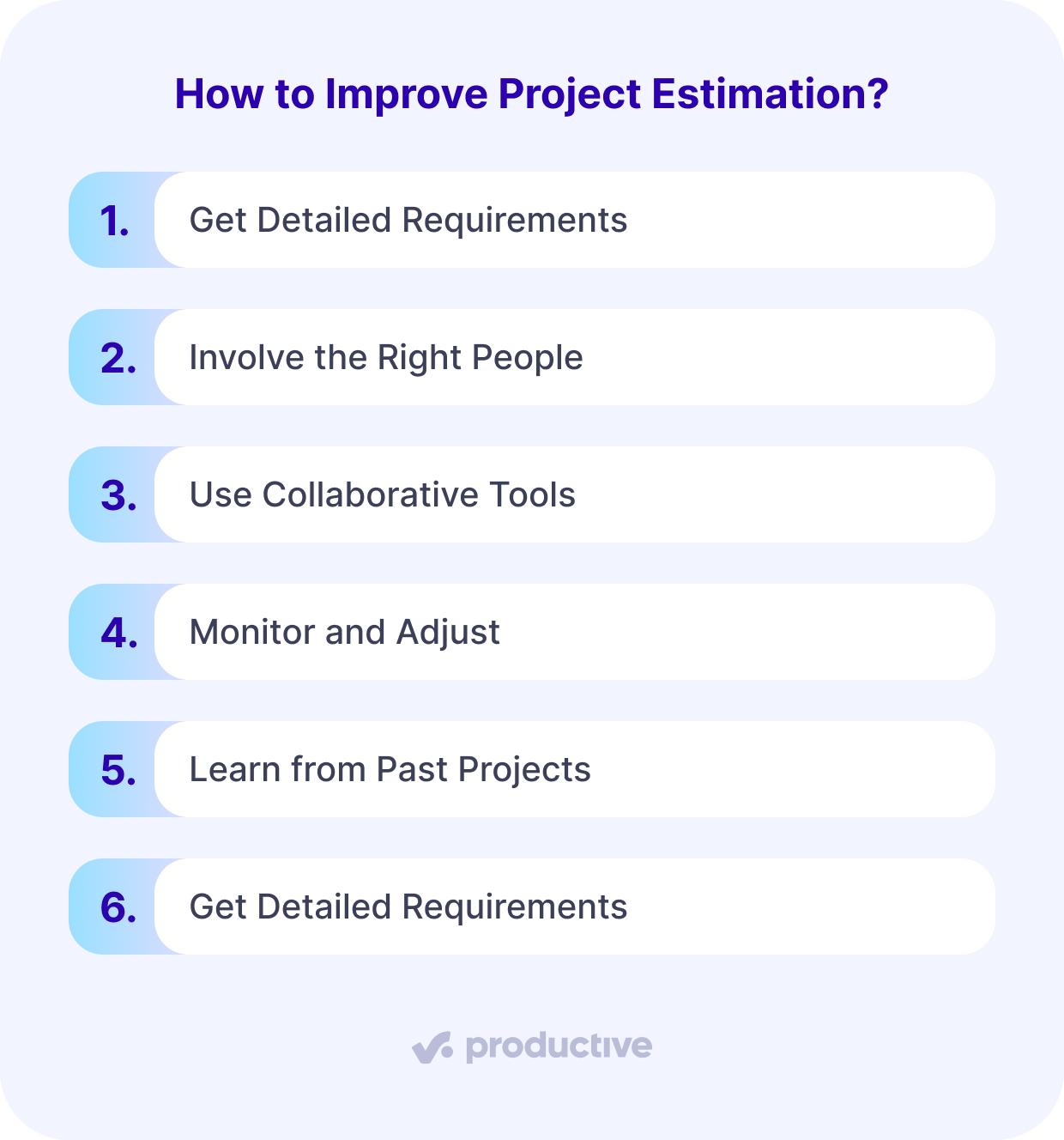
Get Detailed Requirements
Unclear requirements are one of the leading causes of inaccurate estimations. Without specifics, teams have to guess – and those guesses are rarely correct.
To fix this, involve every stakeholder early and ask for complete, structured input. Use interviews, checklists, or collaborative sessions to define the scope clearly and document everything.
As the project evolves, revisit requirements regularly so your estimations stay aligned.
Involve the Right People
Estimates made in isolation often miss real-world complexity. Teams that do the work have the best understanding of how long tasks will take. If you’re the project manager, you need to include developers, designers, and other subject matter experts in your estimation process.
Their insights help you uncover hidden steps, risks, or blockers early, before they derail timelines or budgets.
Use Collaborative Tools
Tools like Productive or Jira allow teams to break work into tasks, assign responsibility, and track real-time progress.
These platforms have templates, shared views, and gather historical data – all of which improve consistency and visibility. When everyone uses the same system to update and refine estimates, you avoid version conflicts and redundant work.
Monitor and Adjust
Initial estimates are only the starting point. As work progresses, track how your actuals compare to forecasts. Use this information to adjust time, cost, and resource expectations. Document any changes and note the reason – this adds transparency and helps you explain shifts to every stakeholder.
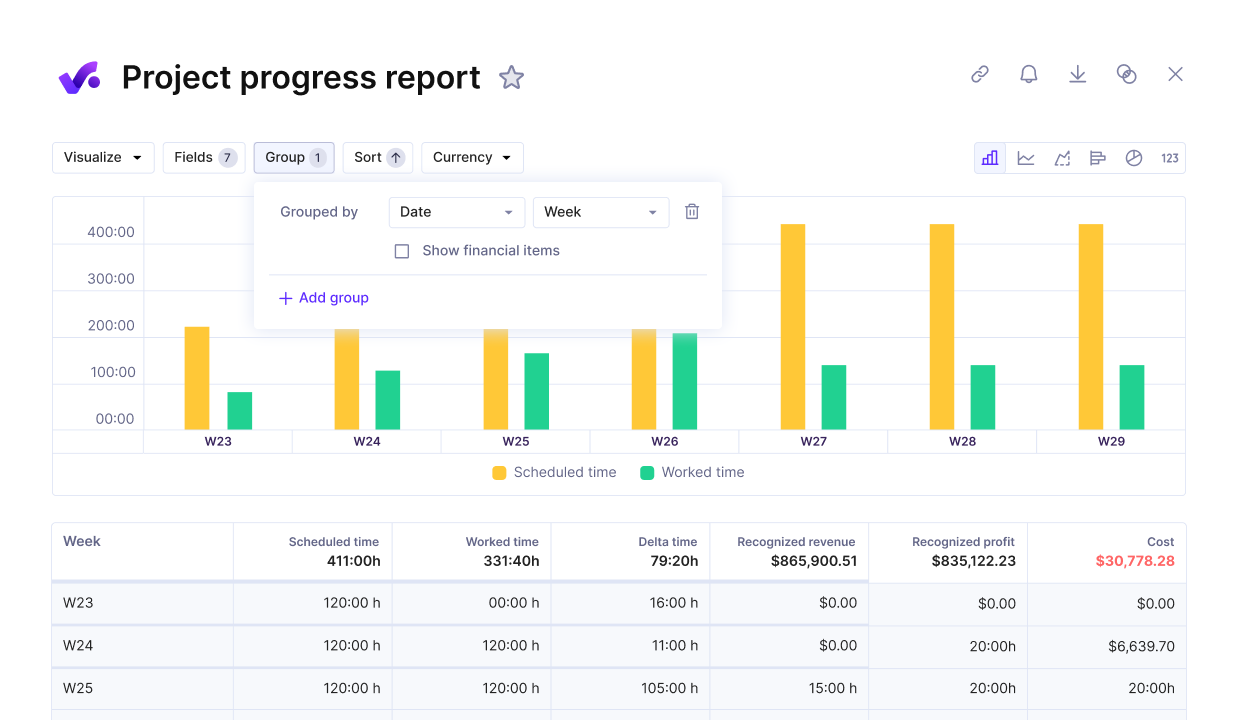
Track project progress in real-time and compare it to your estimates.
Learn from Past Projects
Gathering historical data is one of the best ways to improve future estimates. Using a PM software with time tracking or estimation makes this super easy and straightforward.
After each project, conduct a quick review:
- Where were you accurate?
- What caused the accuracy gap?
- Where did you miss?
Use those learnings to build benchmarks or refine estimation techniques like analogous or parametric models. Over time, this turns your estimation accuracy from educated guesses into reliable (and realistic) baselines.
Get Detailed Requirements
Vague requirements lead to vague estimates. Involve every stakeholder early and gather specifics. Document and revisit requirements as the project evolves.
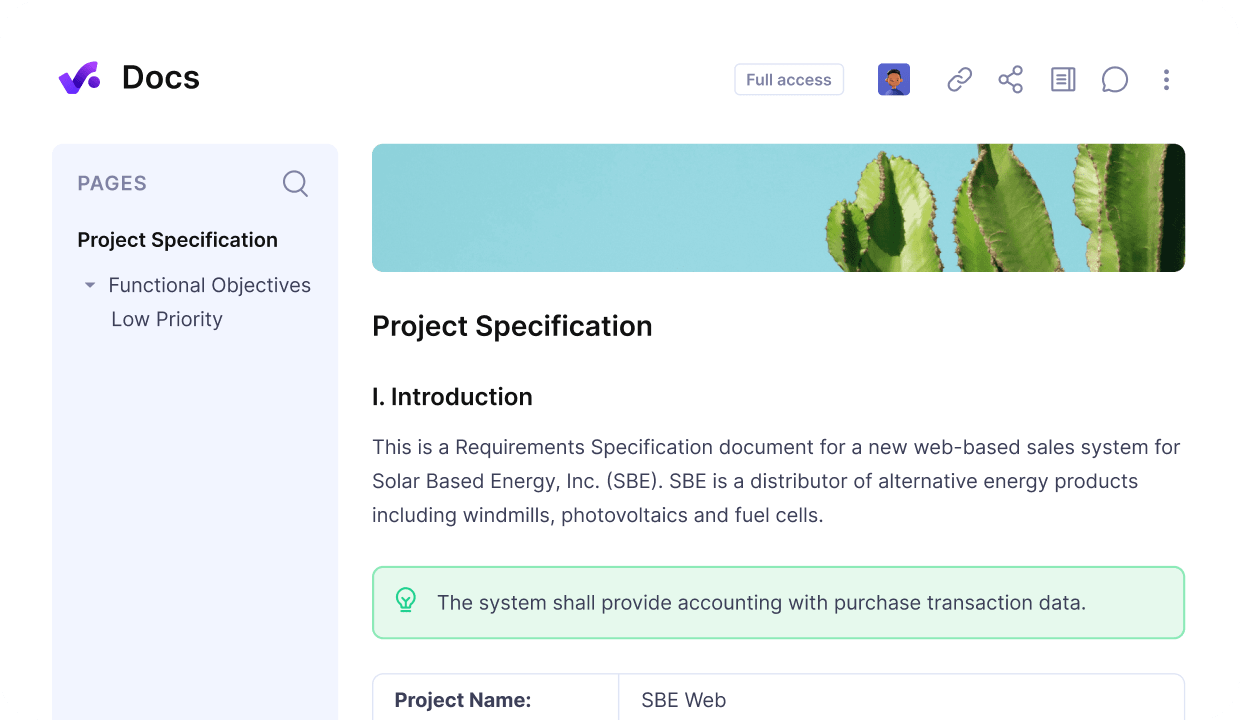
Use Productive to share, comment, and collaborate on project documentation.
What Are the Biggest Challenges in Estimating?
The biggest challenges in estimating are unclear requirements, missing historical data, overly optimistic timelines, team availability issues, and underestimating task dependencies. These issues commonly result in blown budgets, missed deadlines, and frustrated stakeholders.
Below, we expand on each challenge. Stick with the article to find out how to recognize and fix the common challenges in your estimation process.
Common Estimating Problems and How to Solve Them
| Common Challenge | Why It Causes Problems? | How to Fix It? |
|---|---|---|
| Unclear Requirements | Teams make assumptions when the scope is vague, leading to underestimation. | Involve stakeholders early, define specific tasks and goals, and revisit requirements regularly. |
| Missing Historical Data | Without benchmarks, teams guess on duration and cost – often inaccurately. | Start logging actuals now. Even a few completed projects help improve the future estimating process. |
| Overly Optimistic Timelines | Planning for best-case scenarios ignores blockers and delays, resulting in missed deadlines. | Use three-point estimating to factor in realistic, optimistic, and pessimistic outcomes. |
| Ignoring Team Availability | Assuming everyone is fully available ignores vacations, sick days, and split workloads. | Review actual capacity using resource planning tools and adjust timelines accordingly. |
| Underestimating Dependencies | Overlooking task relationships causes delays when one task depends on another. | Map dependencies early using a WBS or timeline view, and identify critical paths. |
What Are Advanced Estimating Techniques?
Advanced estimating techniques are predictive scheduling (e.g., Critical Path Method and PERT), AI and machine learning–based estimation, and Agile estimation frameworks.
These structured methods improve forecast accuracy by using data, team experience, and adaptive processes. Each approach helps teams manage uncertainty and adjust your estimations as project conditions evolve.
Predictive Scheduling
Predictive scheduling methods estimate how long a project will take and what resources it needs (based on the sequence and dependencies of tasks).
One common approach is the Critical Path Method (CPM), which maps out every task, identifies which ones directly impact the final delivery date, and flags any delays that could push the whole project back.
For example, if Task A (2 days), Task B (3 days), and Task C (4 days) must happen in order, the critical path would be 9 days – any delay in these would delay the entire project.
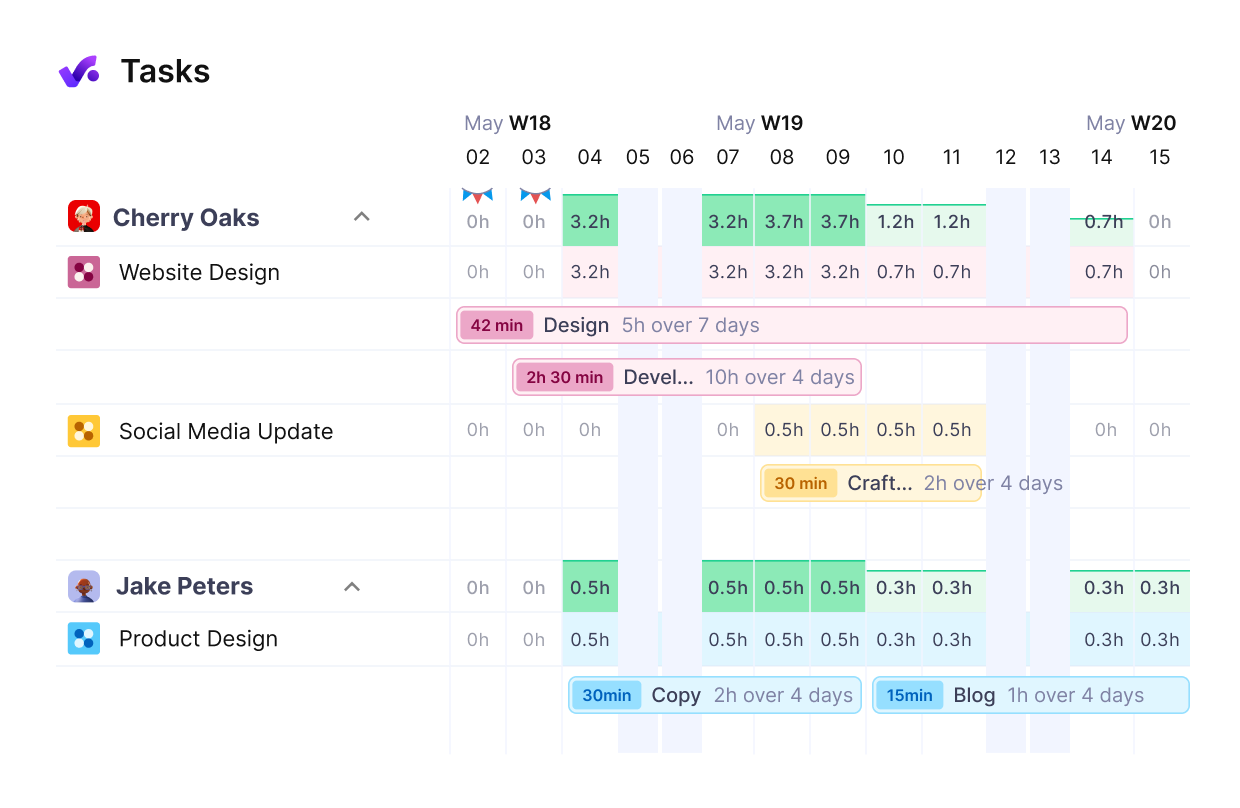
Visualize your team’s workload and easily schedule their time.
AI and Machine Learning
AI and machine learning reduce the guesswork by learning from your team’s past performance and improving estimates over time.
These technologies will help you get more accurate estimations with:
- Pattern recognition and modeling: AI tools analyze past projects to spot trends – like underestimating certain tasks or over-allocating resources (that humans might miss). They then apply these learnings to upcoming projects.
- Forecasting with real-time data: As work progresses, machine learning models adapt their predictions to account for new information. This helps project managers stay ahead of delays or budget overruns.
- Time savings through automation: Instead of manually revisiting estimations every week, AI can update them for you, factoring in progress rates, resource shifts, and task completion data.
Tools like Productive enhance this process by pulling live project data into dashboards and using it to refine future projections. Teams save time, avoid repetitive admin work, and build estimations that stay relevant from kickoff to delivery.
If you’d like to learn more about must-have toolkits, check out our guide on how to choose project management software.
Agile Estimation
Agile estimation techniques emphasize team collaboration and flexibility over rigid planning. Instead of predicting exact hours, teams use story points – relative units of effort based on complexity, risk, and uncertainty.
Their goal is to a realistic estimation of how much work can be completed in a sprint. These estimations are made during backlog refinement sessions and adjusted continuously based on team velocity (the number of story points completed in previous sprints).
What Tools Help With Project Estimation?
Tools that help with project estimation are project management platforms (like Productive), dedicated estimation tools (like WBS builders and parametric calculators), and integrated systems that combine time tracking, budgeting, and forecasting (again, like Productive).
These tools help standardize how a project estimate is created and tracked.
They also reduce manual errors and ensure that your numbers reflect real project conditions (e.g., actual project size estimation or effort estimation). Many agencies still struggle with estimation because their tools don’t sync, leading to double entry, conflicting data, and scope misalignment.
Productive addresses this by connecting your estimations directly with project execution. It helps teams work from a single, accurate source of truth without switching platforms.
Project Management Platforms
Best project management platforms like Jira and Productive help teams build structured estimates, assign tasks, and continuously adjust plans as work progresses.
For many companies and service teams, the biggest challenge is dealing with fragmented systems (jumping between time tracking, spreadsheets, and reporting tools).
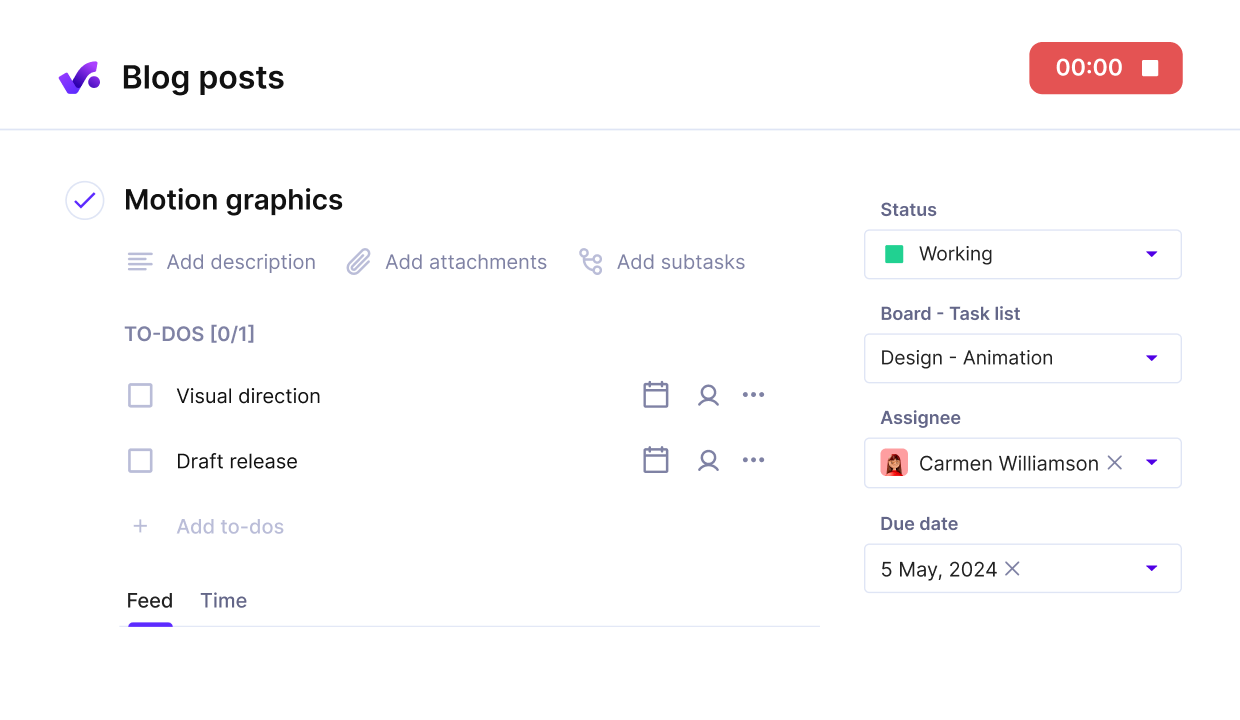
Productive ties all project and financial data in a single source.
That fragmentation leads to poor visibility and missed deadlines. Platforms like Productive solve this by centralizing estimation, time tracking, resource planning, and budgeting into a single workflow.
The result: fewer manual updates, clearer visibility, and smoother project execution without switching tools midstream.
Estimation Tools
Specialized estimation tools help break down complex projects into measurable components using structured methods like Work Breakdown Structures (WBS), parametric models, and cost-per-unit formulas.
These tools are especially useful when working with repeatable project types or needing to create quick forecasts without rebuilding calculations from scratch.
Many companies, however, still rely on disconnected Excel templates or custom scripts, which slow things down and increase the risk of human error. One common pain point we’ve heard repeatedly is the frustration of manually updating estimations across tools that don’t talk to each other.
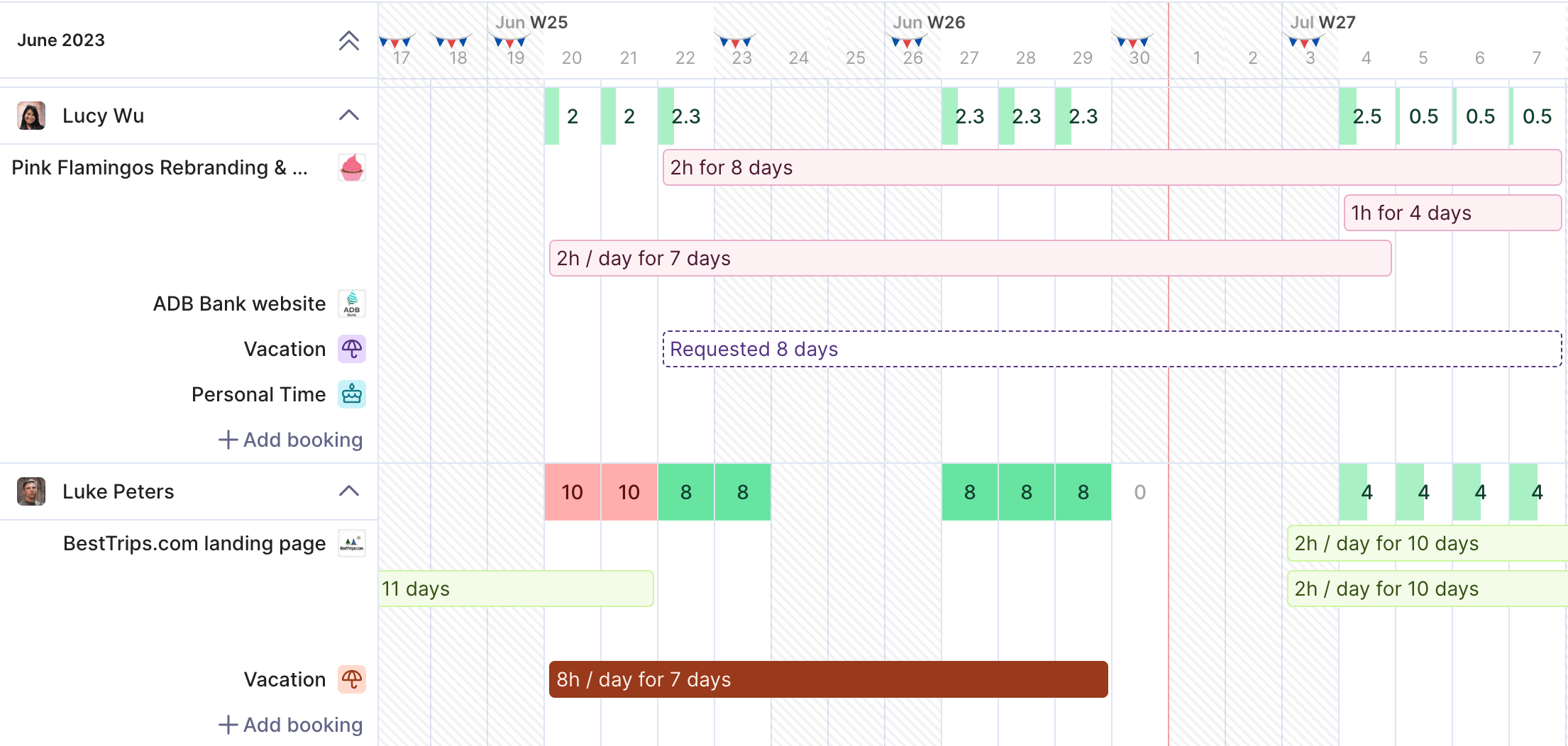
Track all your resource spend and compare it to your estimations.
Tools like Productive solve this by integrating estimation with broader project functions -so time tracking, forecasting, and resourcing feed directly into your budget and progress tracking.
Instead of switching between systems, you keep your estimations synced to real work, making planning more accurate and significantly easier to manage at scale.
Integrated Workflows
When your estimation tools sync with project planning platforms, you eliminate redundant data entry, reduce manual errors, and give teams instant access to the latest project status.
This becomes especially valuable in environments where teams juggle multiple tools and workflows. Without integrated planning and estimation, many teams rely on spreadsheets and disconnected systems, which slow down collaboration and cloud visibility.
Final Thoughts
Accurate project estimate techniques require structured frameworks, reliable data, and clear inputs across scope, time, cost, resources, and risk.
This guide covered the most common techniques, key factors that influence accuracy, and tools that make estimation easier to manage. If your current process involves disconnected systems or too much manual work, Productive helps unify your data so you can create more reliable estimations without extra effort.
Book a short demo to see how Productive helps teams estimate faster and deliver with confidence.
Get Accurate Project Estimates with Productive
Switch to structured estimation with one tool that connects scope, time, and budgets in real time.
